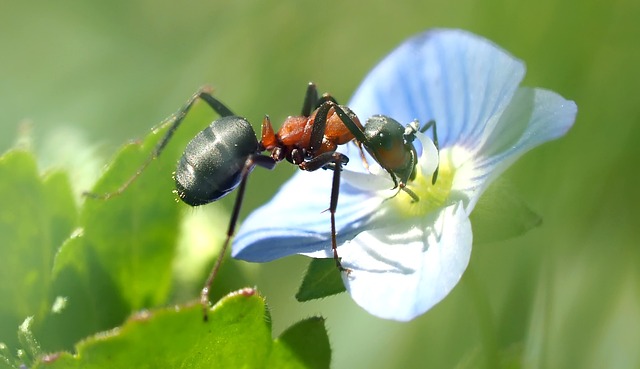Understanding ant communication is key to effective indoor ant control. Pheromone inhibitors and advanced technologies like AI-driven smart devices, sensors, and pheromone traps offer eco-friendly alternatives to traditional pesticides. These innovative solutions disrupt ant activities while minimizing chemical use and harm to humans and pets, making them popular choices for both residential and commercial spaces. As research progresses, these sustainable methods will continue to shape the future of indoor ant control.
Ant trails pose a persistent challenge for indoor spaces, prompting the need for innovative solutions in ant control. This article explores cutting-edge technologies designed to identify and mitigate ant presence, focusing on both traditional and high-tech approaches. We delve into the intricate behavior of ants, from understanding pheromonal communication to deciphering trail patterns. Additionally, we examine modern indoor ant control methods, leveraging sensors and AI, while highlighting future prospects for sustainable and eco-friendly ant management practices, catering to those seeking effective yet responsible solutions.
Understanding Ant Behavior: Unraveling Trails and Pheromonal Communication
Understanding Ant Behavior is Key to Effective Indoor Ant Control. Ants are highly organized social insects that communicate using a complex system of pheromones, leaving a chemical trail for other ants to follow. These trails, often visible as lines on floors or walls, indicate paths to food sources and safe havens. By studying ant behavior and the mechanisms behind trail formation, researchers have developed innovative technologies aimed at disrupting these communication networks.
One such technology employs artificial pheromone inhibitors, which interfere with the ants’ ability to detect and follow trails. These substances mimic natural pheromones but bind to receptors in a way that disrupts the trail’s chemical signal. This approach not only aids in indoor ant control but also offers a more environmentally friendly alternative to traditional pesticides by targeting specific behaviors without harming non-target species.
Traditional vs. Innovative Indoor Ant Control Methods
In the realm of indoor ant control, traditional methods have long relied on chemical pesticides, which can be effective but come with drawbacks such as health risks and environmental impact. These conventional approaches often involve targeting ants directly or leaving out bait stations in hopes of luring them away. However, with evolving technology, innovative solutions are emerging to revolutionize indoor ant management.
Innovative indoor ant control methods leverage advanced technologies like pheromone monitoring systems and smart pest control devices. Pheromone-based traps use synthetic ant pheromones to attract and capture ants discreetly, reducing the need for chemical applications. Smart pest control devices utilize sensors, AI, and automated releases of natural repellents or insect growth regulators to disrupt ant trails and colonies without harming humans or pets. These cutting-edge techniques offer safer, more eco-friendly alternatives that are proving effective in combating ant infestations while minimizing environmental and health concerns.
High-Tech Solutions: Using Sensors and AI for Ant Management
Ants, with their intricate trail-building behavior, pose a unique challenge for indoor spaces, where traditional methods often fall short. This is where high-tech solutions come into play, offering innovative approaches to ant management. Sensors and artificial intelligence (AI) are at the forefront of this revolution, providing precise and effective strategies for indoor ant control.
Advanced sensors can detect minute traces left by ants, allowing for early identification of their presence. These sensors, strategically placed in problem areas, use chemical analysis to pinpoint pheromones and other substances that indicate ant activity. Once detected, AI algorithms step in, analyzing the data and mapping out ant trails with remarkable accuracy. This technology enables targeted interventions, ensuring that only affected areas are treated, minimizing the use of chemicals and promoting eco-friendly indoor environments.
The Future of Ant Control: Sustainable and Environmental Friendly Approaches
The future of ant control lies in sustainable and environmentally friendly approaches that minimize harm to both the ants themselves and the surrounding ecosystem, especially when it comes to indoor ant control. Traditional methods often rely on toxic chemicals, which can be detrimental to health and the environment. However, innovative technologies are emerging to change this. One such advancement is the use of pheromone-based repellents and traps, which disrupt ant communication without harming them directly. These solutions not only provide effective indoor ant control but also contribute to a greener, more sustainable approach to pest management.
Additionally, the integration of smart sensors and AI in ant control systems promises precision and efficiency. These technologies can detect ant trails, predict their paths, and deploy targeted treatments only where needed. This not only reduces the use of chemicals but also makes indoor ant control more effective and less disruptive to non-target organisms and the environment. As our understanding of ants’ behavior and ecology continues to evolve, we can expect these sustainable methods to become increasingly prevalent in both residential and commercial settings.
Ant trails represent a complex communication network that, when understood, can be exploited for effective indoor ant control. By combining traditional methods with innovative technologies such as sensors, AI, and sustainable practices, we can achieve more precise and environmentally friendly pest management. As research progresses, these cutting-edge solutions promise to revolutionize the way we deal with ant infestations, ensuring a cleaner and greener future for both homes and businesses. For efficient indoor ant control, adopting these advanced strategies is key to staying ahead of these persistent pests.
